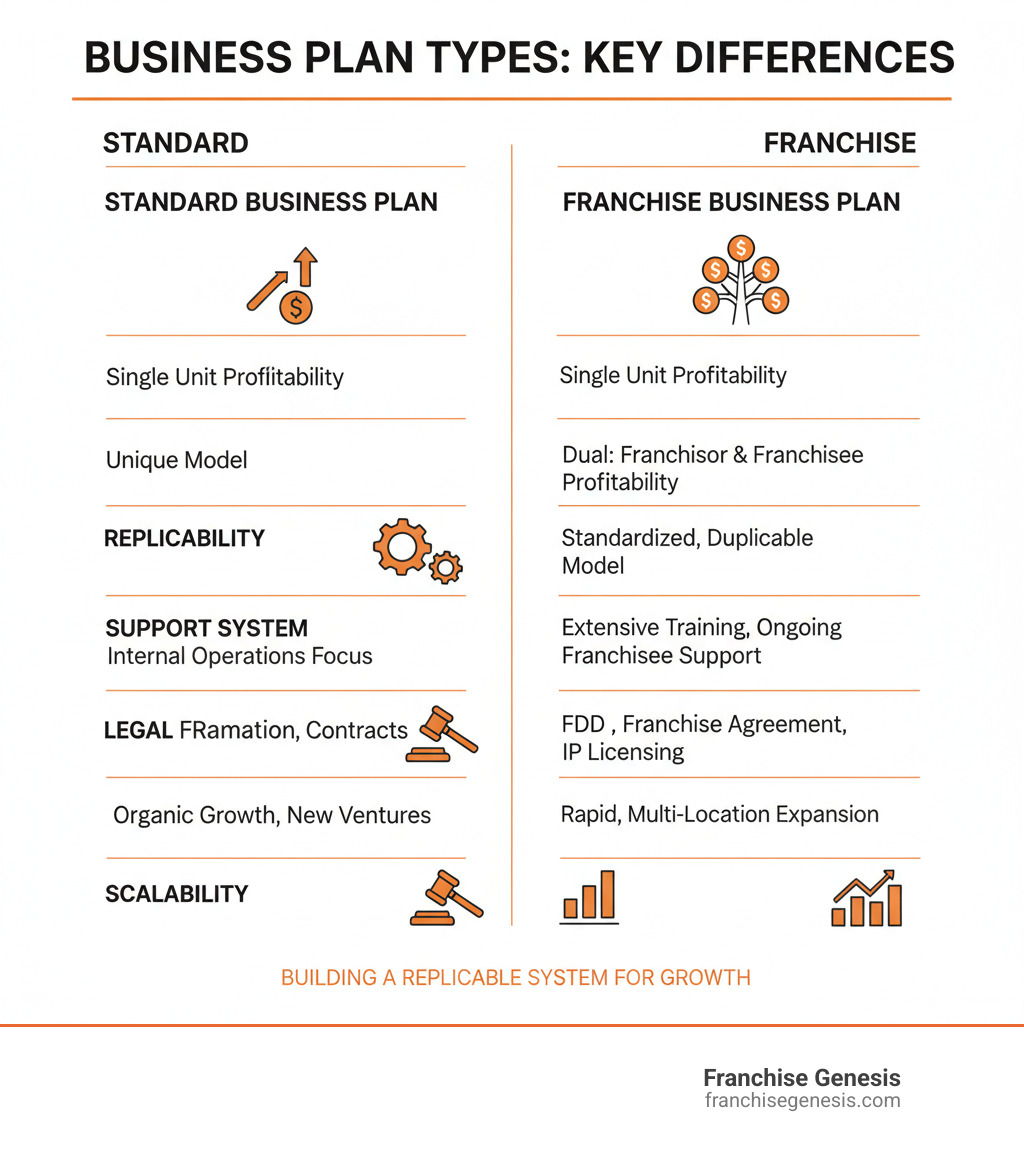Why Your Franchise Business Plan is the Foundation of Expansion
A franchise business plan is a strategic document outlining how you will scale your successful business into a franchise system. It’s your roadmap for growth, proving to investors, lenders, and prospective franchisees that your model is replicable and profitable. Unlike a plan for a single location, it must demonstrate that both your core business and the franchise system itself are sound investments.
Key elements of a franchise business plan include:
- Executive Summary – Your elevator pitch for the franchise opportunity
- Company Description – Your brand story and why it’s franchise-ready
- Franchise Model – Fee structure, royalties, and investment breakdown
- Market Analysis – Industry trends and target territories
- Operations Plan – Training systems and franchisee support
- Marketing Strategy – How you’ll recruit and support franchisees
- Management Team – Leadership capability and experience
- Financial Projections – Revenue streams for both franchisor and franchisees
- Supporting Documents – FDD, legal agreements, and detailed data
The franchise industry in the United States represents an $800 billion market. Franchises with fees between $25,000 and $100,000 have a 5-year failure rate of just 5%—a fraction of the overall business failure rate. A well-crafted plan is essential for proving your concept’s viability. It forces you to think through the operational, legal, and financial complexities of franchising before you commit significant resources.
Much of the foundational information comes from your Franchise Disclosure Document (FDD). As Vice President of Operations at Franchise Genesis, I’ve guided business owners through creating plans that have secured millions in funding and attracted hundreds of franchisees. The process requires intentional planning, but it becomes your most powerful tool for expansion.

Why a Franchisor Business Plan is Your Blueprint for National Growth
Think of your franchise business plan as the architectural blueprint for building something much bigger than a single successful location. You’ve proven your concept works—now it’s time to show investors and potential franchisees that it can work at scale, across multiple markets, with different owners at the helm.
Securing capital is where your plan does its heaviest lifting. Lenders need to see the entire franchise infrastructure mapped out, including revenue from fees and royalties, franchisee support systems, and your startup costs as a franchisor. Without detailed answers, funding conversations stall. Most lenders expect you to personally finance a significant portion of the total debt, making a rock-solid plan even more critical. Understanding How Much Does It Cost to Franchise My Business? is an essential first step.
Your plan also proves you’re serious. Presenting a comprehensive document that addresses operations, training, marketing, and financials for both your company and your future franchisees shows you’ve done your homework. This strategic tool becomes your guide for Franchise Unit Growth, setting clear benchmarks for expansion. It forces you to answer the tough questions about maintaining quality control, training new owners, and recruiting the right partners.
For a deeper understanding of the expansion process, check out our Ultimate Business Scaling Guide. Your franchise business plan isn’t just a document you create once—it’s the living foundation of everything you’ll build as a franchisor.
The 9 Core Components of Your Winning Franchise Business Plan

Creating a comprehensive franchise business plan requires several components that work together to tell your complete story. This section breaks down the essential parts from a franchisor’s perspective, showing you how to structure your system for success and attract the right partners.
1. Executive Summary
Though written last, your Executive Summary is read first. It’s your elevator pitch in written form—a snapshot that captures your mission, the franchise opportunity, your funding requirements, and key financial highlights that prove your concept works. It should compel readers to dive into the details.
2. Company Description & Brand Story
Share your journey—how you built your business, the milestones you’ve achieved, and what makes your brand special. This is your origin story, focused on why your proven business model is ready for replication. Your Unique Selling Proposition needs to shine, showing you’ve established a consistent brand identity ready for new locations, as detailed in your Franchise Brand Guidelines.
3. The Franchise Model & Opportunity
Explain the nuts and bolts of your franchise structure, including which model you’re offering:
| Franchise Model | Description |
|---|---|
| Unit Franchise | Grants a franchisee the right to operate a single unit. |
| Multi-Unit Franchise | Grants a franchisee the right to open and operate more than one unit, usually within a specific territory, under a development schedule. |
| Area Developer | Grants a franchisee the right to open and operate multiple units, and also find and support other franchisees within a large territory. |
Detail your franchise fee, ongoing royalty fees (typically around 6% of gross revenue), and the complete initial investment. Beyond the numbers, articulate the benefits for franchisees. What makes your opportunity compelling? This section must show your business is not just scalable, but genuinely replicable.
4. Market & Industry Analysis
Prove your concept has room to grow with a data-backed industry overview, noting market size and growth rates. Define your target market for franchisees and conduct a thorough competitor analysis. Your Franchise Feasibility Study helps identify ideal territories by analyzing consumer behavior and local market factors. This proves your concept is practically replicable across diverse markets, from communities like Huntersville, NC to nationwide.
5. Operations & Training Plan

This section is the backbone of your system. Outline the comprehensive support that will keep your brand consistent. Detail your initial training program and your ongoing Franchise Training Success programs. Describe your supply chain management, required technology, and quality control standards to ensure a consistent customer experience. Reference your Franchise Operations Manual, which codifies your business into a step-by-step guide. This manual is key to ensuring consistency and franchisee confidence.
6. Franchise Sales & Marketing Strategy
Your plan needs a two-pronged marketing approach. First, detail how you’ll attract qualified franchisees through tactics like online portals, expos, and digital marketing. Second, show franchisees how you’ll help them attract customers. Explain your national brand marketing fund and the local marketing support you’ll provide, such as a digital toolkit or grand opening support plans. Your Franchise Sales & Marketing strategy should show a clear path from prospect to partner.
7. Management Team
Investors and franchisees are betting on you and your team. Provide detailed bios for your founder and executives, highlighting relevant industry and management experience. Detail the key staff who will directly support franchisees, outlining their roles. If you have an advisory board with legal or financial experts, introduce them to demonstrate your leadership capability and reassure stakeholders.
8. The Franchisor Financial Plan
Your financial plan must show viability for both you and your franchisees. Detail your franchisor revenue streams (initial fees, royalties, etc.). Crucially, provide realistic financial projections for a typical franchisee unit. Detail estimated startup costs, operating expenses, and projected revenue and profit margins (e.g., Year 1 revenue of $200,000 with a 15% profit margin). Include a break-even analysis, which is often 12-18 months for strong franchise models. Outline your own startup costs as a franchisor, which we help you calculate in How Much Does It Cost to Franchise My Business?. Finally, present detailed Pro forma financial statements for both the franchisor and a franchisee unit for 3-5 years.
9. Appendix & Supporting Documents
Your Appendix is the evidence that backs up your claims. Include a summary of your Franchise Agreement, an outline of your FDD Document, detailed financial spreadsheets, market research data, and resumes of your key management team. Every document here should add credibility to your proposal.
Using Your Plan to Secure Funding and Attract Franchisees

Your franchise business plan is an active sales tool for two key audiences: lenders who can fund your expansion and entrepreneurs who can join your network.
When meeting with banks or investors, your plan is the primary tool for evaluating risk. It demonstrates the scope of your project, your capabilities, and the financial viability of the venture. A plan with conservative financial projections, thorough market analysis, and a clear operational strategy significantly increases your chances of securing capital. We walk you through this process in How to Get a Business Loan for franchising.
The plan is also your most powerful recruitment tool. Prospective franchisees are considering a major investment—often $100,000 to $150,000 or more. They need proof that it makes sense. Your plan provides that proof by demonstrating the profitability potential of a unit with real numbers. It outlines the initial investment, ongoing costs, and what they get in return: brand recognition, proven systems, and comprehensive support that dramatically reduces their risk.
When you present your plan, you’re inviting them into a partnership. A transparent and thorough plan builds the confidence needed to transform interested prospects into committed franchise partners. It opens doors to funding through Franchise Capital Solutions and attracts the quality franchisees who will turn your vision of national growth into a tangible reality.
Avoiding Pitfalls: Legalities and Long-Term Strategy
Even a brilliant business concept can stumble during franchising if you don’t anticipate the challenges. Your franchise business plan should help you steer these potential pitfalls from the start.
One of the biggest mistakes is underestimating ongoing support costs. Franchising isn’t just collecting fees; it’s building a support infrastructure. This includes training, operational guidance, marketing, quality control, and technology. Your financial projections must realistically account for these expenses, including dedicated support staff.
Another pitfall is a business model that isn’t truly replicable. If your success depends on your unique personal talent or specific local conditions, you’ll struggle to scale. Your plan must demonstrate how your operations manual and training create consistency, allowing a franchisee in Charlotte to achieve similar results to one in Asheville.
The importance of specialized legal counsel cannot be overstated. Franchising involves complex federal and state regulations. Your Franchise Legal Requirements include creating a compliant Franchise Disclosure Document (FDD) and crafting protective franchise agreements. Cutting corners on legal expertise early on can lead to expensive problems later.
Finally, your franchise business plan is a living document. Review and update it at least annually, or whenever your market, model, or growth strategy shifts. This continuous review allows you to adapt, refine your Franchise Growth Strategies, and ensure your roadmap remains relevant as your network expands. Treating it as a static document is a recipe for getting left behind.
Frequently Asked Questions about Creating a Franchise Business Plan
How does a franchise business plan differ from a plan for an independent startup?
A standard business plan aims to prove one business can succeed. A franchise business plan must do more: it proves your business model can be successfully replicated by someone else, in a different market, without your daily involvement. It focuses on the systems you’ve built to make this possible—your training, support, operations manuals, and brand standards. You’re documenting a replicable framework that others can invest in and execute.
What financial projections are most important for a franchisor’s business plan?
You need to present two complete financial pictures. First, project your own revenue as the franchisor from initial franchise fees, ongoing royalties, and other contributions. This shows investors your business is sound. Second, and just as important, you must provide detailed pro forma financials for a typical franchisee unit. This includes their startup costs, operating expenses, and realistic revenue and profit projections. If you can’t show that franchisees will be profitable, you won’t attract quality partners.
How often should I update my franchise business plan?
Treat your franchise business plan as a living document, not a one-time project. We recommend a thorough review at least annually, but more frequently in the early years of franchising. You should update the plan whenever something significant changes, such as reaching a growth milestone, adjusting your fee structure, or responding to a market shift. This ensures your plan remains a relevant strategic tool that guides your decisions and accurately represents your opportunity to investors and franchisees.
Conclusion
Your franchise business plan is more than just paperwork—it’s the cornerstone of your entire franchising journey. This comprehensive document transforms your vision of a national brand into a concrete, achievable roadmap. It’s what will convince investors that your concept is worth funding, persuade talented entrepreneurs that your franchise is worth buying, and guide you through the complexities of building a thriving network.
Think of it this way: you’ve already proven your business works in one location. Now you need to prove it can work in ten, fifty, or even a hundred locations. That’s exactly what a well-crafted franchise business plan accomplishes. By carefully detailing your franchise model, your comprehensive support systems, and your financial strategy for both franchisor and franchisee success, you’re laying the groundwork for sustainable, Accelerated Brand Growth.
At Franchise Genesis, we’ve walked alongside dozens of business owners as they’ve made this change. We’ve seen how a strategic, thorough plan becomes the difference between struggling to find your first few franchisees and building momentum that carries you to national recognition. Your plan isn’t just a document you create once and file away—it’s a living blueprint that evolves as your franchise system grows and matures.
The journey from successful business owner to successful franchisor requires careful planning, strategic thinking, and the right partnership. If you’re ready to take that first critical step toward building your franchise empire, we’re here to help. Explore our Services for Franchisors and Franchisees to find how Franchise Genesis can guide you through creating a franchise business plan that sets you up for long-term success. Your national brand is waiting—let’s build it together.
